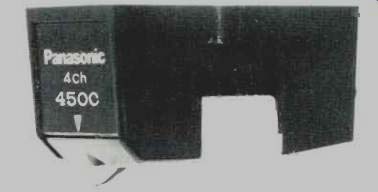
THE EVOLUTION of the transducer for reproducing recorded sound since Edison's
invention of the phonograph (1877) and, subsequently, the Berliner Gramophone,
has been remarkable. The transducer used with the Berliner flat disc was of
the acoustical-mechanical type. With the advent of electronic amplifiers, the
subsequent transducers included the torsional-twisting Pfansthiehl, the Weathers
FM demodulator type (which had to be tuned not unlike today's CD-4 cartridge),
a variety of piezoelectric units, the moving magnet and the moving coil types,
and finally, the strain-gauge (semiconductor) type.
Modern cartridges convert to convolutions of a recorded groove, as traced by the stylus, into an electrical signal. These cartridges fall into one of two classes--either the amplitude responding or velocity-responding category. Most cartridges are of the velocity-responding type, while such cartridges as the piezoelectric and piezoresistive types are amplitude-responding. The piezo-resistance types includes the strain-gauge (semiconductor) type, where the stylus movement varies the resistance of the semiconductor elements. Unlike the piezoelectric cartridge, the piezoresistive element does not develop a signal directly. When at rest, it is a simple resistor with a fixed value. Apply pressure or strain and the resistive value changes correspondingly. By applying a voltage to this resistor, the resultant current changes in step with the change in resistance.
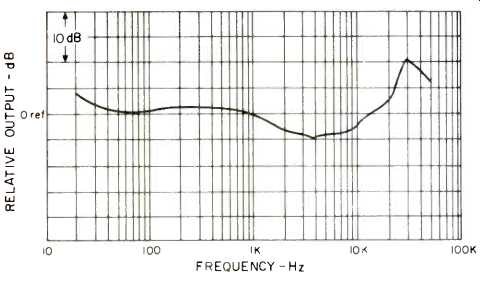
Fig. 1--Panasonic EPC-450C cartridge.
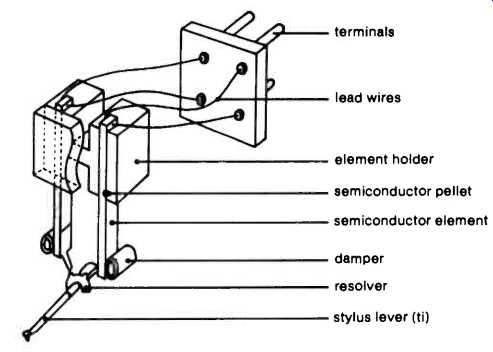
Fig. 2--Stylus assembly of the EPC-450C.
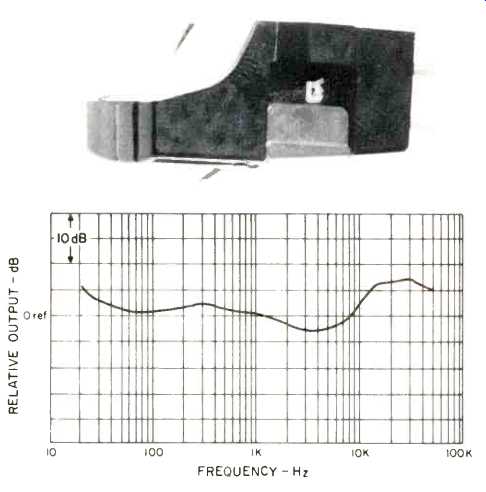
Fig. 3--Panasonic EPC-450C-II cartridge.
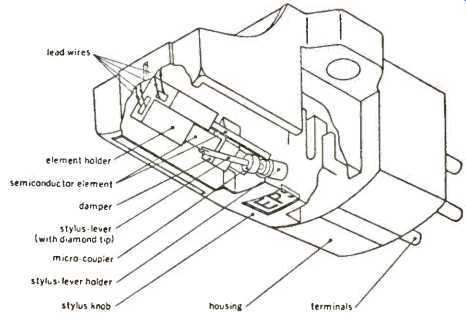
Fig. 4--Stylus system of the EPC-450C-II.
The Panasonic EPC-450C cartridge, developed by Shuichi Obata in Japan, is a strain-gauge (semiconductor) type (Fig. I). The stylus assembly (Fig. 2) consists essentially of a nude Shibata diamond stylus mounted on a light-weight titanium stylus lever. When the low-mass stylus assembly is inserted into the cartridge, it rests against an almost invisible metal resolver and assumes the relationship to the cartridge's moving system.
When the record-groove undulations swing the stylus lever, they cause the metal resolver to press alternately against the two piezoresistive semiconductor elements (silicon sensor), causing them to change their resistive value correspondingly.
However, there is no signal present unless the elements are supplied with a bias voltage, which is normally available from the Panasonic SE-405H CD-4 demodulator. As the piezoresistive elements change their resistive value, they modulate the direct current present, thus creating a corresponding signal in the CD-4 demodulator. Since the cartridge does not directly generate an electrical signal, there are no signal loss problems such as those normally associated with magnetic cartridges.
The usual standard connecting cables may be used between the arm and the demodulator inasmuch as the standard cable capacitance does not have an effect on the high frequencies.
However, it is suggested that the total capacitance not exceed 8200pF per stereo side. Also, because there are no coils present, there is no hum pickup.
The frequency response of the strain-gauge cartridge is essentially from d.c. (0 Hz) to 50 kHz. The frequency response characteristics of the Panasonic cartridge is for all intents and purposes equalized for the RIAA recording curve, thus it does not require an equalizer amplifier stage in the demodulator.
Recently, Panasonic introduced a new version of strain gauge cartridge, the EPC-450C-II (Fig. 3) which replaces the now discontinued EPC-450C. The major change in this cartridge is that the two transducer elements and the stylus system are directly coupled by a tiny synthetic rubber ring ("Micro coupler"). This new system (Fig. 4) overcomes the defects in the conventional "V-shape resolver," thus permitting a more efficient pickup of the vibrations (20-50 kHz) and at the same time increasing channel separation at these ultrasonic frequencies. The operating principle is identical to the EPC-450C. The nude diamond Quadratip stylus is somewhat similar to the Shibata design and covers the same groove contact area.
The EPC-450C stylus lever is made of titanium fused to a duralumin-like metal. The titanium tube has a diameter of 0.35mm, with the wall thickness being 20 u. The stylus is a nude Shibata diamond mounted on the titanium tube. The EPC-450C-II stylus lever is made solely from an aluminum alloy somewhat similar to duralumin and the nude Quadratip diamond is mounted on this lever.
The manufacturer's specifications for the two strain-gauge (semiconductor) cartridges are given below:
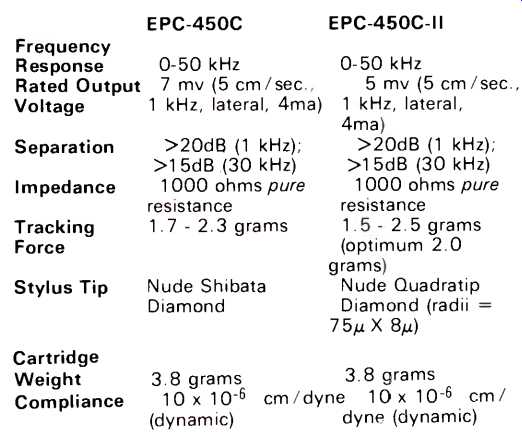
The major disadvantage of the Panasonic strain-gauge cartridges is that they can be used only with the Panasonic built-in or separate demodulator. However, the SE-405H demodulator (Fig. 5) can be used with either the strain-gauge cartridge or any moving magnet cartridge. A switch on the demodulator bypasses the bias voltage producing stage.
The Panasonic strain-gauge cartridges have the RIAA equalization built into them, thus creating a problem in obtaining frequency response curves, IM distortion percentages, and square wave photographs. We have discussed the problem personally with Mr. Shuichi Obata, the developer of the Panasonic semiconductor cartridges. He agreed that unless special equipment is available, it will be most difficult to obtain the desired data. We did manage to obtain a frequency response curve through 50 kHz by using the Brüel & Kjaer (B&K) Response Test Unit 4409, Spectrometer 2113, Level Recorder 2305, and some other associated B&K equipment. However, we found it impossible to obtain separation curves because of some noise being generated more than 25 dB below the frequency response curve. We also were unable to obtain IM distortion data and square wave photographs from the Columbia STR-111 test record, despite the excellent equipment used. This problem is now being investigated and should we succeed in obtaining these parameters, they will be reported at a later time. Mr. Obata has shown us tracings that indicate separation for the EPC-450C-II cartridge from 20 to 100 Hz to be better than 20 dB, 30 dB from 100 1000 Hz, 20 dB from 1 8 kHz, 19 dB at 10 kHz, 20 dB at 15 kHz, 24 dB at 20 kHz, 22 dB at 30 kHz, 24 dB at 40 kHz, and 23 dB at 50 kHz, using the B&K QR-2009 and the JVC TRS-1005 test records. This is remarkable separation data which must be confirmed.
Measurements
As is our practice, measurements are made on both channels, but only the left channel is reported.
EPC-450C
The frequency response curve for this cartridge is + 4.5 dB at 20 Hz, + 2 dB from 20 Hz to 1 kHz,-4 dB from 1 kHz to 10 kHz, rising to + 3 dB at 20 kHz, + 10.5 dB at 30 kHz, + 8
dB at 40 kHz, and dropping to + 6.5 dB at 50 kHz. Wt. 3.75 g; d.c. res. 850 ohms; Output 1.44 mv/1-cm/sec; Crosstalk 17 dB; Ch. Bal. 1 dB; Trackability: High freq. (10.8 kHz pulsed) 30 cm/sec; Mid-freq. (1000 + 1500 Hz lat. cut) 31.5 cm/sec; Low freq. (400 + 4000 Hz lat. cut) 24 cm/sec; Optimum tracking 2.0 g.
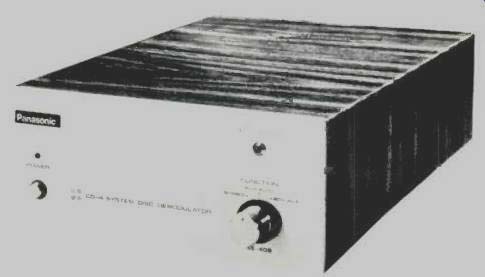
Fig. 5--SE-405H CD-4 demodulator.
EPC-450C-II
The frequency response curve for this cartridge is + 6 dB at 20 Hz, + 1.5 dB at 100 Hz, + 2 dB at 500 Hz, 2 dB at 2 kHz, 2.5 dB at 5 kHz, + 2 dB at 10 kHz, + 5.5 dB at 15 kHz, + 7 dB at 20 kHz, + 7.5 dB at 30 kHz, + 6.5 dB at 40 kHz, and + 5.5 dB at 50 kHz.
Wt. 3.33 g; d.c. res. 1493 ohms; Output 1.13 mv/1-cm/sec; Crosstalk 27 dB; Ch. Bal. 1 dB; Trackability: High freq. (10.8 kHz pulsed) 30 cm/sec; Mid-freq. (100 + 1500 Hz lat. cut) 31.5 cm/sec; Low freq. (400 + 4000 Hz lat. cut) 24 cm/sec; Optimum tracking 2.0 g.
Listening Evaluation
The listening evaluation was made using all the CD-4 records previously reported in AUDIO, March 1974. We have added to this group of CD-4 records the Shostakovich Symphony No. 15, RCA Quadradisc, ARD1-0014. The last three eights of an inch of recorded music on Side B has a high frequency bell sound that is most difficult to track and reproduce clearly. Up to now, we have found that only the Audio-technica AT2OSL cartridge has been able to reproduce these high frequencies without some shattering sounds. The Panasonic EPC450C-II also reproduces these high frequencies without any shattering sounds. The sonic clarity of this cartridge is quite smooth, with the transient and bass response being excellent.
However, the strain-gauge (semiconductor) cartridges do not seem to have quite the definition of the top CD-4 cartridges reported in AUDIO, March 1974. We believe the EPC-450C-II is about on par with the Audio-technica AT 15S cartridge. In terms of music reproduction, the EPC-450C cartridge does not seem to perform as well as the EPC-450C-II.
-B.V. Pisha
(Audio magazine, Aug. 1974)
Also see:
Ortofon MC 2000 Phono Cartridge and T 2000 Transformer (Equip. Profile, Dec. 1984)
Micro Acoustics 630 Phono Cartridge (Mar. 1984)
Phono Equalization Kits--various models (Mar. 1979)
= = = =